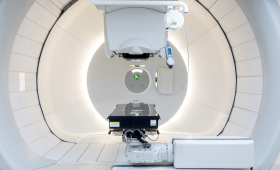Proton Therapy System (IBA Plus one)

System Introduction
1、What is proton therapy?
The so-called proton refers to the particle with a positive charge after the hydrogen atom loses its electrons.
Proton therapy is a relatively advanced tumor radiotherapy treatment technology in the world today.
2. Characteristics of proton therapy
Proton therapy is a non-invasive and high-precision radiation therapy method. In traditional radiation therapy, X-rays entering the body cause significant damage around the tumor tissue. Protons have a unique physical characteristic called the Bragg peak. Protons emit very little energy before reaching the tumor, almost without damaging normal tissue. Proton beams enter normal tissue at a very low dose, and energy is rapidly released after entering the tumor tissue Directional blasting, after penetrating tumor tissue, rapidly attenuates energy, thereby preventing damage to surrounding normal tissues.
3.Compared with traditional radiotherapy, proton therapy has the following advantages:
(1) Increased radiation dose to the tumor target area, thereby improving tumor control rate;
(2) Reducing energy irradiation in non lesion areas reduces damage to normal tissues and organs in the human body, and reduces side effects related to radiotherapy;
(3) Children are extremely sensitive to radiation and are prone to adverse reactions caused by radiation damage. Proton therapy can effectively protect children's physiological functions and reduce the impact on their physical development and intelligence;
(4) Improve quality of life, improve local tumor control rate and survival rate;
(5) Reduce the risk of secondary tumors;
(6) Providing new treatment methods for patients who cannot undergo surgery;
(7) This provides an opportunity for patients who have relapsed after traditional radiation therapy in the past to undergo secondary radiation therapy.
4.Proton therapy can effectively treat various types of tumors, mainly suitable for solid tumors that have not spread widely to other parts of the body, including:
Head and neck tumors: eye tumors, craniopharyngioma, chordoma of the skull base, chondrosarcoma of the skull base, nasopharyngeal carcinoma, malignant tumors of the nasal cavity and sinuses, parotid gland malignant tumors, oropharyngeal carcinoma, oral malignant tumors, adenoid cystic carcinoma, tongue root carcinoma, laryngeal carcinoma, recurrent head and neck malignant tumors;
Chest tumors: lung cancer, esophageal cancer, thymoma, malignant pleural mesothelioma, lung metastasis, breast cancer;
Abdominal and pelvic tumors: liver cancer, bile duct cancer, pancreatic cancer, stomach cancer, kidney cancer, rectal cancer, anal cancer, prostate cancer, bladder cancer cancer, endometrial cancer, cervical cancer, vaginal cancer;
Central nervous system tumors: meningiomas, gliomas, pituitary tumors, medulloblastomas, ependymomas, intracranial germ cell tumors, primary central nervous system lymphoma, spinal cord tumors;
Bone and soft tissue tumors: leiomyosarcoma, epithelioid sarcoma, Ewing's sarcoma, osteosarcoma, chondrosarcoma, sacrococcygeal chordoma, giant cell tumor of bone, hemangiopericytoma, and endothelial cell tumor;
Skin tumors: malignant melanoma, squamous cell carcinoma of the skin;
Hematolymphatic system tumors: Hodgkin's lymphoma, non Hodgkin's lymphoma;
Children's tumors.
Related videos
-
 Can Traditional Chinese Medicine Treat Lung Cancer: Saving or Killing Lives
Can Traditional Chinese Medicine Treat Lung Cancer: Saving or Killing Lives一洲在线
-
 Many of these four types of cancer can survive for a long time
Many of these four types of cancer can survive for a long time健康在线
Recommended Reading
-

Great Lecture Hall | Development and Trends in Cancer Therapy
2023-09-01 08:14:00 -

Happy birthday in the ward, let the children smile more brightly
2023-08-29 14:10:55 -

Post flood reconstruction in Zhuozhou, Yizhou Cancer Hospital in action
2023-08-29 11:59:27 -
Our hospital has organized post disaster free clinics in communities such as Shui'an Flower City in Zhuozhou City
2023-08-26 11:42:37




